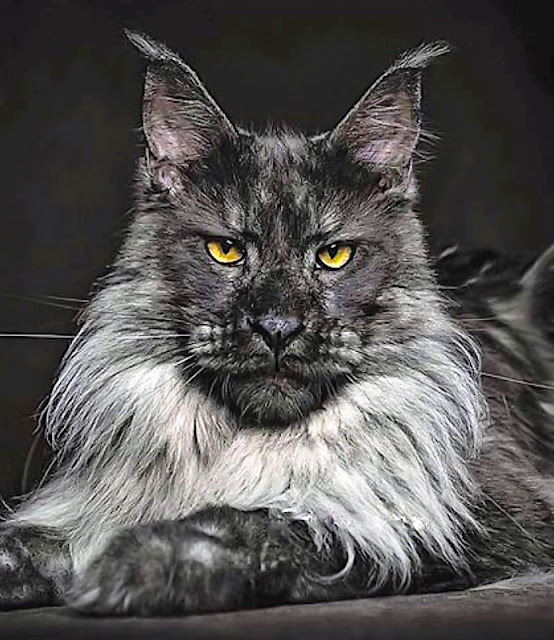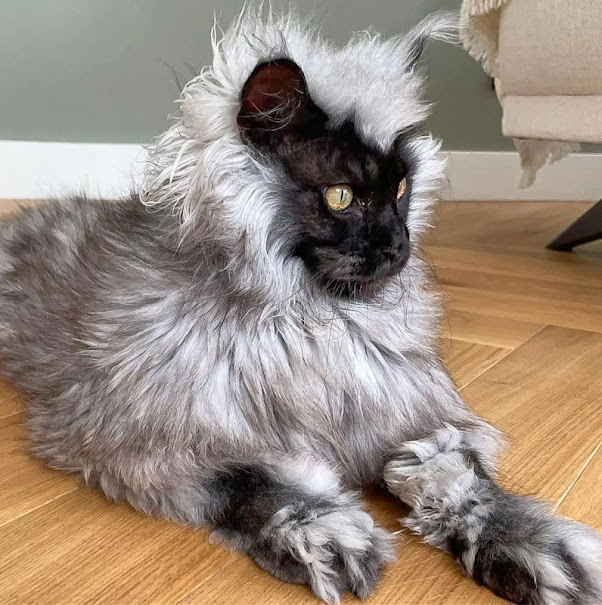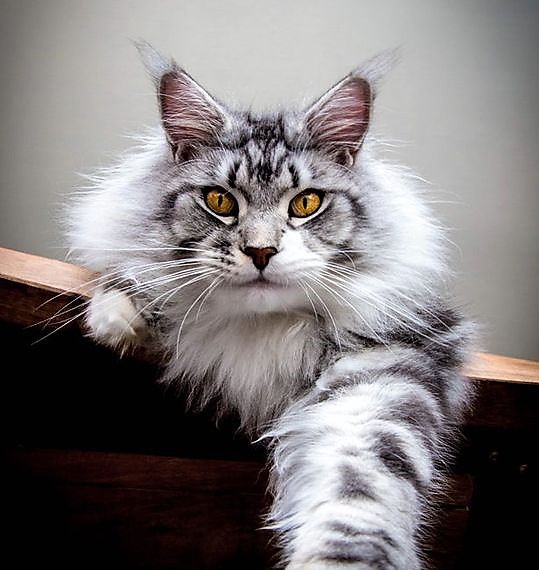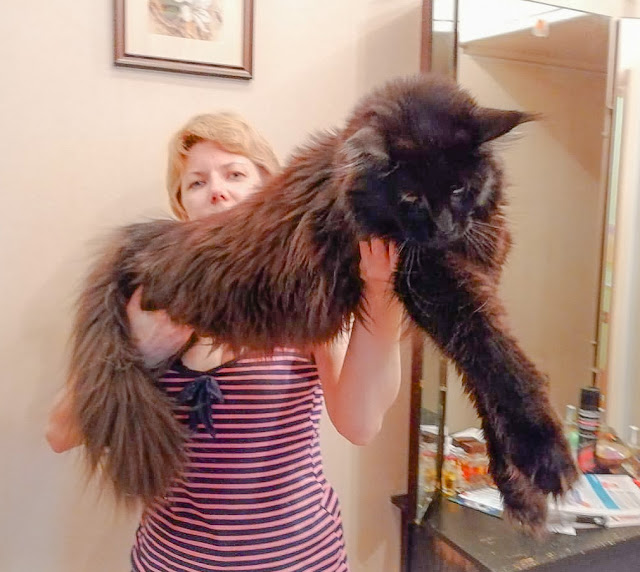Maine Coon is the most popular cat breed but the 9th most attractive as per the 'golden ratio'
In an apparent anomaly, a study measuring beauty using the 'golden ratio' organised by the website All About Cats concluded that the Maine Coon is the 9th most attractive cat breed with the most attractive breeds being the Norwegian Forest cat together with the Russian Blue. I say "anomaly" because it is likely that the Maine Coon is today's most popular cat breed.
 |
| Russian Blue - mathematically the most beautiful. Image: Daily Mail. |
Explaining the difference between mathematical beauty and observed beauty
In another anomaly, the Persian and the Himalayan, both flat-faced-bread cat breeds, are the least attractive under a mathematical formula called the "golden ratio". Both these breeds are popular among the cat fancy. For decades, the Persian was the most popular cat breed as recognised by the Cat Fanciers' Association (most registrations).
There are three possible reasons for this anomaly. The first is that the popularity of a cat breeder is not relied upon its attractiveness. That is highly implausible so I will throw that idea into the bin. Popularity among cat breeds is pretty well wholly dependent upon the cat's attractiveness.
The other possible reason is that this ancient mathematical measurement of beauty in humans called, as mentioned, the "golden ratio", is unsuited to working out whether a cat is attractive or not.
The third reason is linked to the second namely that the cat associations' breed standards for the Maine Coon insist upon a large, square muzzle and very large erect ears. Both these features are bred to an extreme. This is going to conflict with the golden ratio mathematical formula. This is why the Maine Coon is seen as attractive subjectively but not the most attractive objectively. The former is not suitable really for extreme bread cats.
 |
| Maine Coon family and their caregiver. Picture in the public domain (assessed). |
The golden ratio
The principal of the golden ration works on the basis that when various facial elements such as eyes, nose, ears and chin et cetera are in a certain proportion and when the face is more symmetrical, that face is decided by people in general to be attractive or indeed beautiful.
My understanding of the golden ratio is that you take these measurements from a frontal view of a person's face. You then put the measurement into a formula and you're looking for a ratio of 1:1.62. In the case of the study of cat breeds they compared their results with this optimum ratio. They found that the Norwegian Forest cat and the Russian blue where the nearest to 1:1.62. The full list is at the base of the page.
Another problem with this golden ratio rule is that it does not work in profile. That is my understanding. The foreshortened muzzle of the popular French bulldog and Persian is a heavy distortion of naturalness and normality. It actually makes the dog or cat less healthy. This hinders survival. This must go against the golden ratio. And yet both the French bulldog and the Persian are popular with the public (surge in adoptions of French bulldog during Covid). Once again this indicates a clash between the subjectivity of people's appraisal of beauty and a mathematical formula which tries to objectify beauty.
And this leads me to the inevitable conclusion. Mathematical formulae to work out attractiveness are limited. We all know the adage: 'beauty is in the eye of the beholder'. And there's the saying that 'there's no accounting for taste'. An assessment of beauty is highly subjective. Mathematics is highly objective. There is a chasm between them.
Symmetry
There is, however, a sound basis for the golden ratio which is symmetry. People find other people attractive if there facial features are symmetrical. This is because symmetry supports the idea that the person is healthy. People want to marry and procreate with a healthy person because their offspring will be healthy. Ultimately it's down to the survival of the species in this case the human species.
And symmetry is based upon mathematical measurements so there is value in this concept. However, as mentioned, I don't think it really is very applicable to domestic cat. It doesn't take into account the coat colour and markings. It doesn't take into account the size of the cat. Size is an important factor in assessing beauty. And also profiles are important. Selective breeding significantly impacted the profile of many cats particularly the Persian flat-face. The Himalayan, by the way, is a pointed flat-faced Persian.
Conclusion
My conclusion is that the mathematical formula to work out attractiveness can be a basis for the beginning of working out the beauty of an individual either human or feline but it cannot be the entire picture. You have to overlay that basis with subjectivity and the opinions of different people which will vary widely.
Ranking domestic cat beauty as per the formula
| Rank | Cat Breed | Ratio Result | Difference from Golden Ratio of 1.62 | ||||
|---|---|---|---|---|---|---|---|
| 1 | Norwegian Forest | 1.65 | 0.03 | ||||
| 1 | Russian Blue | 1.65 | 0.03 | ||||
| 1 | Manx | 1.59 | 0.03 | ||||
| 4 | Ragamuffin | 1.67 | 0.05 | ||||
| 4 | Siberian | 1.67 | 0.05 | ||||
| 6 | American Curl | 1.56 | 0.06 | ||||
| 7 | Selkirk Rex | 1.69 | 0.07 | ||||
| 7 | Siamese | 1.55 | 0.07 | ||||
| 9 | Maine Coon | 1.71 | 0.09 | ||||
| 10 | Egyptian Mau | 1.72 | 0.10 | ||||
| 10 | Turkish Angora | 1.72 | 0.10 | ||||
| 12 | American Bobtail | 1.73 | 0.11 | ||||
| 13 | American Wirehair | 1.74 | 0.12 | ||||
| 13 | Birman | 1.74 | 0.12 | ||||
| 13 | Pixiebob | 1.74 | 0.12 | ||||
| 16 | American Shorthair | 1.49 | 0.13 | ||||
| 17 | Korat | 1.76 | 0.14 | ||||
| 17 | Ocicat | 1.76 | 0.14 | ||||
| 17 | Ragdoll | 1.76 | 0.14 | ||||
| 20 | Chartreux | 1.77 | 0.15 | ||||
| 21 | Scottish Fold | 1.78 | 0.16 | ||||
| 22 | LaPerm | 1.79 | 0.17 | ||||
| 23 | European Burmese | 1.85 | 0.23 | ||||
| 24 | Munchkin | 1.86 | 0.24 | ||||
| 25 | Balinese-Javanese | 1.88 | 0.26 | ||||
| 25 | Japanese Bobtail | 1.88 | 0.26 | ||||
| 25 | Tonkinese | 1.88 | 0.26 | ||||
| 28 | Bombay | 1.92 | 0.30 | ||||
| 29 | Toyger | 1.93 | 0.31 | ||||
| 30 | Turkish Van | 2.01 | 0.39 | ||||
| 31 | Bengal | 2.03 | 0.41 | ||||
| 32 | Somali | 2.05 | 0.43 | ||||
| 33 | British Shorthair | 2.06 | 0.44 | ||||
| 34 | Sphynx | 2.07 | 0.45 | ||||
| 35 | Burmese | 2.11 | 0.49 | ||||
| 35 | Cornish Rex | 2.11 | 0.49 | ||||
| 37 | Abyssinian | 2.16 | 0.54 | ||||
| 38 | Oriental | 2.21 | 0.59 | ||||
| 39 | Devon Rex | 2.25 | 0.63 | ||||
| 39 | Savannah | 2.25 | 0.63 | ||||
| 41 | Havana Brown | 2.55 | 0.93 | ||||
| 42 | Singapura | 3.37 | 1.75 | ||||
| 43 | Exotic Shorthair | 3.83 | 2.21 | ||||
| 44 | Persian | 7.49 | 5.87 | ||||
| 45 | Peterbald | 19.78 | 18.16 | ||||
| 46 | Himalayan | 58.49 | 56.87 |










Comments
Post a Comment
Please share your Maine Coon experiences.